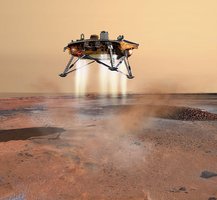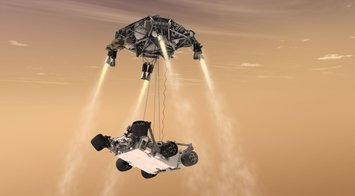V0.1 - 22-06-2020
Landing system
The landing system is responsible for nullifying the remaining kinetic energy in the vehicle. Landings are characterized by a sudden deceleration, which can be damaging to the crew of payload. When the terminal velocity of the vehicle, thus the deceleration upon hitting the ground, is too high, a landing system is required. Generally, there are three landing zones: land, water, and mid-air.
Land landing
When landing on land one can use a variety of hardware to ensure the vehicle comes to a stop. For non-lift generating vehicles these are crushable structures, inflatable structures, or propulsive landing. An example of the first system is a honeycomb structure at the bottom of the vehicle that breaks when the vehicle lands, this is comparable to the crumple zone of a car. The advantage of this system is that it is passive and does not require activation. The drawback is that the system is characterized by very high decelerations. Inflatable structures, such as airbags, are inflated before the ground is reached, this can be done using either a gas stored at high pressure or a gas generator which generates the gas from a solid matter. Airbags can be seen on crewed missions such as the Boeing Starliner or Mars missions such as Spirit and Opportunity. Inflatable structures also require the separation of the heat shield from the capsule. The last option, propulsive landing, requires a propulsion system of some sort to decelerate the vehicle. This can either be the system the vehicle already has such as the Falcon 9 first stage, a dedicated retrorocket pack such as the Soyuz capsule, or an air-breathing engine. The final method only works for lift-generating vehicles and consists of a runway landing. This system is described on the non-parachute landing page.
Water landing
Water landings have the main advantage that water can allow for more gradual deceleration compared to land. This means that no dedicated landing system might be required. This strongly depends on the requirements of the payload. The Apollo capsule did not use any form of the landing system, where the Mercury mission extended the heat shield to allow for a crushable zone. Passive attenuation systems are more efficient at velocities under 5 m/s and active systems are more efficient above 5 m/s.
Retro-rockets are particularly very effective during water landings. Apart from providing deceleration, impinging rocket plumes create a wave-free dish-shaped impact surface and also create a "foamy" compressible layer which provides a cushioning effect on the capsule. Water landings do introduce the need for a floatation device. This device has to ensure the capsule remains afloat in the right orientation.
Apollo 15 splashdown
Mid-air retrieval
Mid-Air Retrieval or Mid-Air Recovery (MAR) uses a helicopter or aircraft to catch the spacecraft in mid-air. This can either be done by grabbing the main parachute or a dedicated structure when the main parachute has to be reused or is not strong enough to be caught. Using MAR means that (usually) no dedicated landing system is required and that retrieval is much easier. However, it does mean that a crewed aircraft is required to be in close proximity of the capsule.
Two examples of mid air recovery (Corona and Genisis)
Trade-off and considerations
There are multiple trade-off criteria considered when it comes to selecting the landing surface. Geopolitics plays a role as access to oceans or large plains of uninhabited land may be a determining factor. The weight of land landing systems is often higher than those of water landing systems. In the case of Orion, the difference was about 680 kg. Safety also plays a major role as well. The chances of injury from anomalies are significantly higher for land landings as opposed to water landings. However, there is always a risk of drowning in water landings as seen in the Liberty Bell 7 mission. Other considerations include the recovery operation and post-flight operations. Where a land landing might require a single truck to retrieve the capsule, a fleet of ships might be required for a water landing.
Landing on Mars
All Mars missions use a similar type of Entry and Deceleration, but they differ in their landing systems. A dedicated landing system is required for a Mars landing as the parachutes would otherwise be too large. There are four main ways of landing on Mars: Airbags, propulsive landing, sky crane or a ballistic impact.
Airbags
One system that has been used in the Mars Pathfinder and Mars Exploration Rovers (Spirit and Opportunity) is an airbag system. The airbag system was inflated using cooled solid rocket engines and stopped the missions from moving. The Mars Pathfinder, however, bounced about 15 times before coming to a standstill and bounced almost 15 meters into the air. Even though this is quite an aggressive landing, the deceleration was limited to 18 g's.
The airbags are often inflated using a solid rocket motor-like system. These systems burn for a few dozen seconds keeping the bags at pressure. When they burn out, the bags are left to deflate, and the shell can open. Using airbags has the advantage that it is a fairly passive system; thus, when it is inflated, it remains inflated and does not require a complex control algorithm for controlling the landing. On the downside, the landing site is undefined as the lander bounces around for a bit. Furthermore, an airbag landing system can end up on the wrong panel and is thus upside down.
Airbag system for the pathfinder mission
Propulsive landing on Mars
Propulsive landing
Other Mars missions such as Phoenix, InSight, and the Viking landers, use a form of propulsive landing. All these missions use an aeroshell with a supersonic capable parachute for the entry and descent. After the parachute has decelerated sufficiently, the parachute is cut away and the rocket motors take over. This system has a downside that it requires a complex control algorithm. However, it does allow for a (more) precise landing. This results in a high-accuracy landing and a hazard-avoidance option. A downside mentioned in some literature is that the exhaust of the engines contaminates the landing location and thus the science that will be done.
That propulsive landing is a complicated feat to perform as shown in the ESA Schiaparelli and NASA Polar lander mission which failed during this phase of landing.
Skycrane
Most people interested in Mars landings remember the date the 6th of August 2012, the date the sky crane was first used. The sky crane is a concept that was introduced as Curiosity was too heavy for an airbag system. A landing system using propulsive landing would require engines so large it would contaminate the rover with dust. The entry and descent of Curiosity happened much like the other missions, in an aeroshell with a supersonic capable parachute system. The sky crane would take over and slow down into a hover. From this hovering platform, the rover was wheeled down to the surface using cables, when the rover detected a safe landing, it would decouple from the harness, and the sky crane would fly away, crashing. Even though this system is immensely complex, it was a great success and will be applied on the Mars 2020 rover as well.
Skycrane system used on the Curiosity mission
Ballistic impact
Some Mars missions did not have a parachute system onboard and impacted ballistically on the surface of Mars. For some missions, this was even the plan. These missions, unfortunately, never resulted in a successful landing. Mars 96 was a very ambitious Russian mission consisting of an orbiter, lander and penetrator. The mission experienced a failure during launch and never left Earth orbit. The second mission Deep Space 2 piggybacked with the ill-fated Mars Polar Lander. Even though the penetrators separated from the Polar Lander, they never established communication after landing. It is still unclear why the landing failed.
Penetrators have the advantage that no form of decelerator hardware is required, and thus the mass and complexity can be reduced. However, this also means that the impact velocity with the ground is quite high. The structural mass to ensure a safe landing might not be beneficial compared to the mass of the decelerator. These missions are often used to inspect the subsurface of a planet.







